| Solar eclipse of January 4, 1992 | |
|---|---|
 Map Map | |
| Type of eclipse | |
| Nature | Annular |
| Gamma | 0.4091 |
| Magnitude | 0.9179 |
| Maximum eclipse | |
| Duration | 701 s (11 min 41 s) |
| Coordinates | 1°00′N 169°42′W / 1°N 169.7°W / 1; -169.7 |
| Max. width of band | 340 km (210 mi) |
| Times (UTC) | |
| Greatest eclipse | 23:05:37 |
| References | |
| Saros | 141 (22 of 70) |
| Catalog # (SE5000) | 9490 |
An annular solar eclipse occurred at the Moon's ascending node of orbit between Saturday, January 4 and Sunday, January 5, 1992, with a magnitude of 0.9179. A solar eclipse occurs when the Moon passes between Earth and the Sun, thereby totally or partly obscuring the image of the Sun for a viewer on Earth. An annular solar eclipse occurs when the Moon's apparent diameter is smaller than the Sun's, blocking most of the Sun's light and causing the Sun to look like an annulus (ring). An annular eclipse appears as a partial eclipse over a region of the Earth thousands of kilometres wide. Occurring about 1.5 days before apogee (on January 6, 1992, at 11:40 UTC), the Moon's apparent diameter was smaller.
The duration of annularity at maximum eclipse (closest to but slightly shorter than the longest duration) was 11 minutes, 40.9 seconds in the Pacific. It will have been the longest annular solar eclipse until January 2, 3062, but the solar eclipse of December 24, 1973 lasted longer.
Annularity was visible in the Federal States of Micronesia, Nauru, Kiribati, Baker Island, Palmyra Atoll, Kingman Reef, and southwestern California, including the southwestern part of Los Angeles. A partial eclipse was visible for parts of Northeast Asia, Northern Australia, Oceania, Hawaii, and western North America.
Observations
In San Diego, the eclipse was described as "thrilling", with one observer saying it "looked like God was putting out a fire in the ocean". At other locations (like northeast Australia and the southern Philippines), it was partially obscured by clouds. Most attempts to view the eclipse from Los Angeles were unsuccessful due to cloud cover (and rain which ruined several campsites set up for eclipse-viewing). An astronomer there said that, while around ten thousand people had gathered there to watch the event, it was "completely socked up" and "as if there was no eclipse at all".
While it was only a partial eclipse in Hawaii, people nonetheless gathered to watch it; a museum reported 3,000 people in attendance during the event, although it was noted that "it was hard to tell who were there for the eclipse and who just kind of stumbled upon it".
Images
Eclipse details
Shown below are two tables displaying details about this particular solar eclipse. The first table outlines times at which the moon's penumbra or umbra attains the specific parameter, and the second table describes various other parameters pertaining to this eclipse.
| Event | Time (UTC) |
|---|---|
| First Penumbral External Contact | 1992 January 04 at 20:04:35.0 UTC |
| First Umbral External Contact | 1992 January 04 at 21:13:17.2 UTC |
| First Central Line | 1992 January 04 at 21:17:01.0 UTC |
| First Umbral Internal Contact | 1992 January 04 at 21:20:46.2 UTC |
| First Penumbral Internal Contact | 1992 January 04 at 22:52:57.9 UTC |
| Greatest Duration | 1992 January 04 at 22:56:52.3 UTC |
| Greatest Eclipse | 1992 January 04 at 23:05:37.0 UTC |
| Ecliptic Conjunction | 1992 January 04 at 23:10:33.0 UTC |
| Equatorial Conjunction | 1992 January 04 at 23:15:42.7 UTC |
| Last Penumbral Internal Contact | 1992 January 04 at 23:18:00.0 UTC |
| Last Umbral Internal Contact | 1992 January 05 at 00:50:20.4 UTC |
| Last Central Line | 1992 January 05 at 00:54:06.6 UTC |
| Last Umbral External Contact | 1992 January 05 at 00:57:51.5 UTC |
| Last Penumbral External Contact | 1992 January 05 at 02:06:36.8 UTC |
| Parameter | Value |
|---|---|
| Eclipse Magnitude | 0.91791 |
| Eclipse Obscuration | 0.84256 |
| Gamma | 0.40908 |
| Sun Right Ascension | 19h00m10.0s |
| Sun Declination | -22°43'13.0" |
| Sun Semi-Diameter | 16'15.9" |
| Sun Equatorial Horizontal Parallax | 08.9" |
| Moon Right Ascension | 18h59m50.7s |
| Moon Declination | -22°21'37.6" |
| Moon Semi-Diameter | 14'43.6" |
| Moon Equatorial Horizontal Parallax | 0°54'02.8" |
| ΔT | 58.3 s |
Eclipse season
See also: Eclipse cycleThis eclipse is part of an eclipse season, a period, roughly every six months, when eclipses occur. Only two (or occasionally three) eclipse seasons occur each year, and each season lasts about 35 days and repeats just short of six months (173 days) later; thus two full eclipse seasons always occur each year. Either two or three eclipses happen each eclipse season. In the sequence below, each eclipse is separated by a fortnight.
| December 21 Descending node (full moon) |
January 4 Ascending node (new moon) |
|---|---|
 |
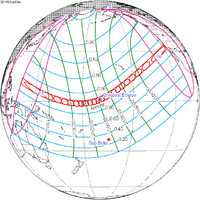
|
| Partial lunar eclipse Lunar Saros 115 |
Annular solar eclipse Solar Saros 141 |
Related eclipses
Eclipses in 1992
- An annular solar eclipse on January 4.
- A partial lunar eclipse on June 15.
- A total solar eclipse on June 30.
- A total lunar eclipse on December 9.
- A partial solar eclipse on December 24.
Metonic
- Preceded by: Solar eclipse of March 18, 1988
- Followed by: Solar eclipse of October 24, 1995
Tzolkinex
- Preceded by: Solar eclipse of November 22, 1984
- Followed by: Solar eclipse of February 16, 1999
Half-Saros
- Preceded by: Lunar eclipse of December 30, 1982
- Followed by: Lunar eclipse of January 9, 2001
Tritos
- Preceded by: Solar eclipse of February 4, 1981
- Followed by: Solar eclipse of December 4, 2002
Solar Saros 141
- Preceded by: Solar eclipse of December 24, 1973
- Followed by: Solar eclipse of January 15, 2010
Inex
- Preceded by: Solar eclipse of January 25, 1963
- Followed by: Solar eclipse of December 14, 2020
Triad
- Preceded by: Solar eclipse of March 6, 1905
- Followed by: Solar eclipse of November 4, 2078
Solar eclipses of 1990–1992
This eclipse is a member of a semester series. An eclipse in a semester series of solar eclipses repeats approximately every 177 days and 4 hours (a semester) at alternating nodes of the Moon's orbit.
| Solar eclipse series sets from 1990 to 1992 | ||||||
|---|---|---|---|---|---|---|
| Ascending node | Descending node | |||||
| Saros | Map | Gamma | Saros | Map | Gamma | |
| 121 | January 26, 1990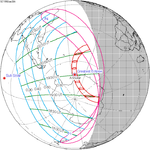 Annular |
−0.9457 | 126 Partial in Finland |
July 22, 1990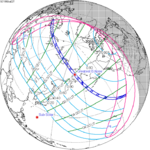 Total |
0.7597 | |
| 131 | January 15, 1991 Annular |
−0.2727 | 136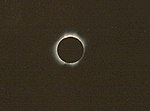 Totality in Playas del Coco, Costa Rica |
July 11, 1991 Total |
−0.0041 | |
| 141 | January 4, 1992 Annular |
0.4091 | 146 | June 30, 1992 Total |
−0.7512 | |
| 151 | December 24, 1992 Partial |
1.0711 | ||||
Saros 141
This eclipse is a part of Saros series 141, repeating every 18 years, 11 days, and containing 70 events. The series started with a partial solar eclipse on May 19, 1613. It contains annular eclipses from August 4, 1739 through October 14, 2640. There are no hybrid or total eclipses in this set. The series ends at member 70 as a partial eclipse on June 13, 2857. Its eclipses are tabulated in three columns; every third eclipse in the same column is one exeligmos apart, so they all cast shadows over approximately the same parts of the Earth.
The longest duration of annularity was produced by member 20 at 12 minutes, 9 seconds on December 14, 1955. All eclipses in this series occur at the Moon’s ascending node of orbit.
| Series members 12–33 occur between 1801 and 2200: | ||
|---|---|---|
| 12 | 13 | 14 |
 September 17, 1811 |
 September 28, 1829 |
 October 9, 1847 |
| 15 | 16 | 17 |
 October 19, 1865 |
 October 30, 1883 |
 November 11, 1901 |
| 18 | 19 | 20 |
 November 22, 1919 |
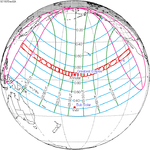 December 2, 1937 |
 December 14, 1955 |
| 21 | 22 | 23 |
 December 24, 1973 |
 January 4, 1992 |
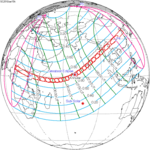 January 15, 2010 |
| 24 | 25 | 26 |
 January 26, 2028 |
 February 5, 2046 |
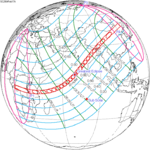 February 17, 2064 |
| 27 | 28 | 29 |
 February 27, 2082 |
 March 10, 2100 |
 March 22, 2118 |
| 30 | 31 | 32 |
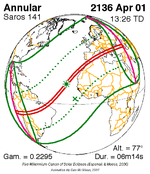 April 1, 2136 |
 April 12, 2154 |
 April 23, 2172 |
| 33 | ||
 May 4, 2190 | ||
Metonic series
The metonic series repeats eclipses every 19 years (6939.69 days), lasting about 5 cycles. Eclipses occur in nearly the same calendar date. In addition, the octon subseries repeats 1/5 of that or every 3.8 years (1387.94 days). All eclipses in this table occur at the Moon's ascending node.
| 22 eclipse events between January 5, 1935 and August 11, 2018 | ||||
|---|---|---|---|---|
| January 4–5 | October 23–24 | August 10–12 | May 30–31 | March 18–19 |
| 111 | 113 | 115 | 117 | 119 |
 January 5, 1935 |
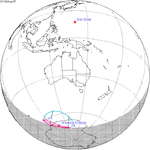 August 12, 1942 |
 May 30, 1946 |
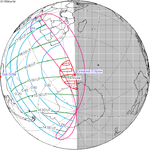 March 18, 1950 | |
| 121 | 123 | 125 | 127 | 129 |
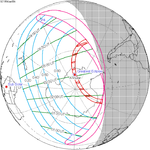 January 5, 1954 |
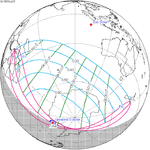 October 23, 1957 |
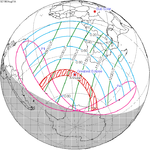 August 11, 1961 |
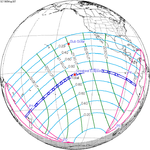 May 30, 1965 |
 March 18, 1969 |
| 131 | 133 | 135 | 137 | 139 |
 January 4, 1973 |
 October 23, 1976 |
 August 10, 1980 |
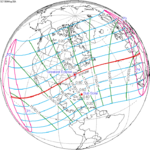 May 30, 1984 |
 March 18, 1988 |
| 141 | 143 | 145 | 147 | 149 |
 January 4, 1992 |
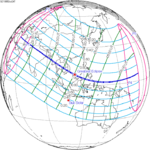 October 24, 1995 |
 August 11, 1999 |
 May 31, 2003 |
 March 19, 2007 |
| 151 | 153 | 155 | ||
 January 4, 2011 |
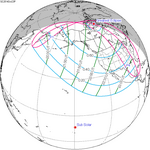 October 23, 2014 |
 August 11, 2018 | ||
Tritos series
This eclipse is a part of a tritos cycle, repeating at alternating nodes every 135 synodic months (≈ 3986.63 days, or 11 years minus 1 month). Their appearance and longitude are irregular due to a lack of synchronization with the anomalistic month (period of perigee), but groupings of 3 tritos cycles (≈ 33 years minus 3 months) come close (≈ 434.044 anomalistic months), so eclipses are similar in these groupings.
| Series members between 1801 and 2200 | ||||
|---|---|---|---|---|
 June 16, 1806 (Saros 124) |
 May 16, 1817 (Saros 125) |
 April 14, 1828 (Saros 126) |
 March 15, 1839 (Saros 127) |
 February 12, 1850 (Saros 128) |
 January 11, 1861 (Saros 129) |
 December 12, 1871 (Saros 130) |
 November 10, 1882 (Saros 131) |
 October 9, 1893 (Saros 132) |
 September 9, 1904 (Saros 133) |
 August 10, 1915 (Saros 134) |
 July 9, 1926 (Saros 135) |
 June 8, 1937 (Saros 136) |
 May 9, 1948 (Saros 137) |
 April 8, 1959 (Saros 138) |
 March 7, 1970 (Saros 139) |
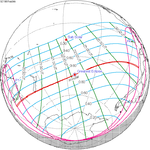 February 4, 1981 (Saros 140) |
 January 4, 1992 (Saros 141) |
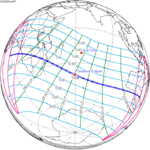 December 4, 2002 (Saros 142) |
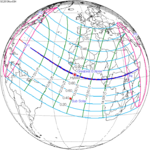 November 3, 2013 (Saros 143) |
 October 2, 2024 (Saros 144) |
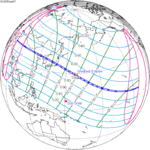 September 2, 2035 (Saros 145) |
 August 2, 2046 (Saros 146) |
 July 1, 2057 (Saros 147) |
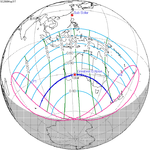 May 31, 2068 (Saros 148) |
 May 1, 2079 (Saros 149) |
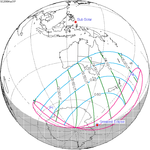 March 31, 2090 (Saros 150) |
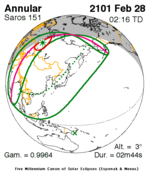 February 28, 2101 (Saros 151) |
 January 29, 2112 (Saros 152) |
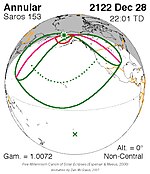 December 28, 2122 (Saros 153) |
 November 26, 2133 (Saros 154) |
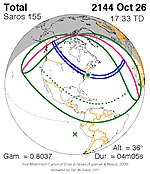 October 26, 2144 (Saros 155) |
 September 26, 2155 (Saros 156) |
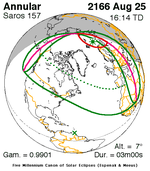 August 25, 2166 (Saros 157) |
 July 25, 2177 (Saros 158) |
 June 24, 2188 (Saros 159) |
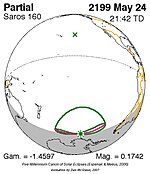 May 24, 2199 (Saros 160) | |||
Inex series
This eclipse is a part of the long period inex cycle, repeating at alternating nodes, every 358 synodic months (≈ 10,571.95 days, or 29 years minus 20 days). Their appearance and longitude are irregular due to a lack of synchronization with the anomalistic month (period of perigee). However, groupings of 3 inex cycles (≈ 87 years minus 2 months) comes close (≈ 1,151.02 anomalistic months), so eclipses are similar in these groupings.
| Series members between 1801 and 2200 | ||
|---|---|---|
 May 5, 1818 (Saros 135) |
 April 15, 1847 (Saros 136) |
 March 25, 1876 (Saros 137) |
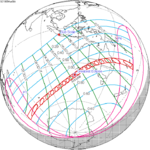 March 6, 1905 (Saros 138) |
 February 14, 1934 (Saros 139) |
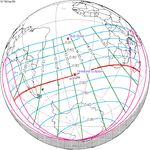 January 25, 1963 (Saros 140) |
 January 4, 1992 (Saros 141) |
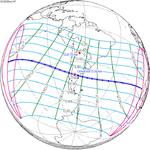 December 14, 2020 (Saros 142) |
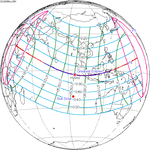 November 25, 2049 (Saros 143) |
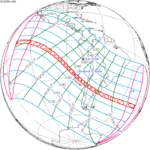 November 4, 2078 (Saros 144) |
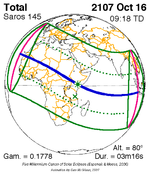 October 16, 2107 (Saros 145) |
 September 26, 2136 (Saros 146) |
 September 5, 2165 (Saros 147) |
 August 16, 2194 (Saros 148) |
|
Notes
- "January 4–5, 1992 Annular Solar Eclipse". timeanddate. Retrieved 10 August 2024.
- "Moon Distances for London, United Kingdom, England". timeanddate. Retrieved 10 August 2024.
- "Annular Solar Eclipses with Durations Exceeding 11m 00s: -3999 to 6000". NASA Eclipse Web Site.
- "Sunset eclipse expected to dazzle West today". The Daily Herald. Provo, Utah. 1992-01-04.
- ^ "Clouds Obscure Eclipse in Some Areas". Tulsa World. 1992-01-05.
- "Clouds conceal solar eclipse". Edmonton Journal. 1992-01-05. p. 1. Retrieved 2023-10-24 – via Newspapers.com.
- "Hundreds hoping to see spectacle are disappointed". Ventura County Star. 1992-01-05. p. 4. Retrieved 2023-10-24 – via Newspapers.com.
- "Partial eclipse: Isle folk were only partially interested". The Honolulu Advertiser. 1992-01-05. p. 3. Retrieved 2023-10-24 – via Newspapers.com.
- "Annular Solar Eclipse of 1992 Jan 04". EclipseWise.com. Retrieved 10 August 2024.
- van Gent, R.H. "Solar- and Lunar-Eclipse Predictions from Antiquity to the Present". A Catalogue of Eclipse Cycles. Utrecht University. Retrieved 6 October 2018.
- "NASA - Catalog of Solar Eclipses of Saros 141". eclipse.gsfc.nasa.gov.
References
- Earth visibility chart and eclipse statistics Eclipse Predictions by Fred Espenak, NASA/GSFC
Photos:
- APOD Ring of Fire Revisited, annular eclipse at sunset



